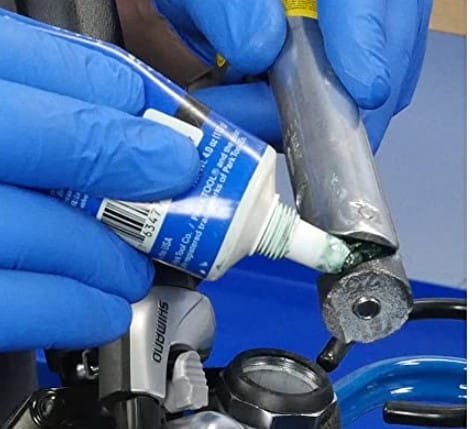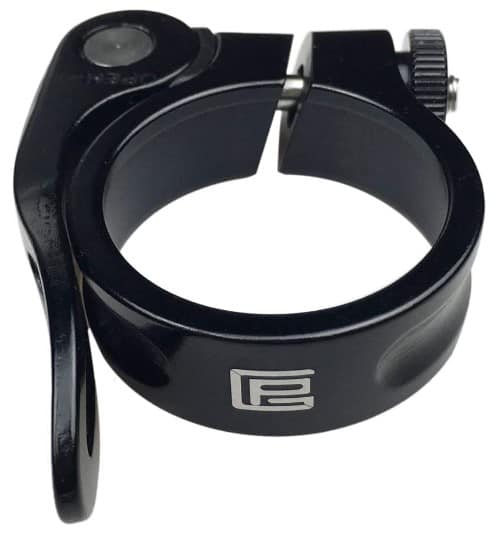When it comes to the moving and threaded parts of a bicycle, lubrication minimizes creaking and wearing out. However, you could be asking, “Should I grease my seatpost yet it has no threads and it doesn’t move?”
You should grease your seatpost on the segment that fits into the seat tube to prevent oxidation and corrosion. Grease also prevents jamming of the seat post in the seat tube and gets rid of creaks. However, you shouldn’t grease carbon fiber seatposts with regular grease.
Carbon installations require different treatment from steel or aluminum. Instead of grease, you need a carbon assembly compound that prevents slipping and corrosion.

Should I Grease My Bike Seatpost?
Let’s go back and answer this basic question, “Should you grease a bike seatpost? Is it necessary if you’re not using steel?
Yes, you should grease your metallic seat post regardless of the metal used.
Although the seat post doesn’t thread or move, you need to grease it to be easy to remove in the future. Actually, steel and aluminum seat posts fuse over time due to oxidation.
As a result, the seat post gets stuck in the seat tube. Unfortunately, removing stuck seat posts can be expensive or cause damages to the bike’s frame.
All the same, a small layer of grease on the seat post will act as a barrier and prevent corrosion.
Actually, most bike manufacturers grease the seat posts and the inner part of the seat tube on their first assembly.
On the other hand, if you have a carbon fiber bike frame or the seat post made of carbon, you don’t grease the setup.
Instead, you have to use a special carbon assembly paste that helps to create friction between carbon parts. In addition, the compound prevents the over-tightening of bolts which could damage the fiber components.
If you have a bike with a carbon fiber frame, you can use the Park Tool Supergrip Carbon and Alloy Assembly Compound, which is ideal for carbon, steel, and aluminum deposits.
How Does Grease Help Seatposts?
Someone might be tempted to use oil to lubricate the seat post, but that is wrong. The only ideal lubricant for a bike’s seat post is grease, despite the two having similar chemical make-up.
The main difference between oil and grease is their viscosity. Specifically, viscosity is the internal friction of a fluid that makes it thick and sticky such that it doesn’t flow easily.
Since the seat post fits vertically on the seat tube, you can only apply a thin layer of oil that would easily drip off. Again, the layer of oil would become thinner as it drips off and leaves ample room for corrosion to occur.
However, since grease has a higher viscosity, applying a thicker layer will hold on for a long time and prevent any possible corrosion.
At the same time, since the seatpost fits tightly on the seat tube, the recess is semi-sealed.
Therefore, the inner part of the assembly stays protected from dust and other debris that grease usually attracts.

How Do You Grease A Seat Post
So far, it is evident that greasing the seat post is necessary, but how do you do it? Do you grease it along the length?
No, you don’t have to grease the whole length of the seat post. The only part that needs greasing is the one that gets into the seat tube.
Therefore, the first step is to mark how deep you will return the seat post. You can do this by placing a piece of tape just on the seat post just above the seat tube. Once you have done that, remove the post.
Using a small paintbrush or an old toothbrush, apply a thin layer of grease on the part of the post below the tape.
Also, for maximum protection from corrosion of the assembly, you need to grease the seat post inside. However, if you apply grease only on the seat post, the installation process might strip most of the grease off.
All the same, you need to apply just the right amount of grease on the assembly since too much of it can make the seatpost slip.
Once you have greased the two parts, re-install the seat post and lower it to the point where you had placed the tape.
How Do I Stop My Seatpost From Slipping?
Some riders avoid greasing their seatpost in the fear that the post would slip. Well, in a perfectly fitting installation, the seatpost should not slip.
Therefore, what causes the seat post to slip, and how can you stop it?
The main reason why seat posts slip is the use of a clamp that won’t tighten properly. Actually, it would be best if you had a clamp that is fit for your seat tube size and riding style.
Generally, a seat clamp’s diameter should match that of the seat tube and not the seatpost. Notably, the post is smaller in diameter than the seat tube.
Therefore, if you need to replace your seat post clamp, the PLATT bike seat clamp is a good choice for your bike with a seat tube that is 28.6mm in diameter. In addition, the clamp comes anodized to prevent corrosion.
The other possible reason why your seatpost is slipping is the application of excess grease. That is why it is important to use just enough lubricant because it will not interfere with your ride’s quality.
On the other hand, if you applied the right amount of lubricant, you may tighten the clamp a little more to avoid the post from lowering.

What Type Of Grease For Bike Seatpost?
Typically, any type of grease will work well with the seat post so long as neither the seat post nor the seat tube is made of fiber.
Most riders use auto parts grease and it works well.
All the same, if you would like to buy some bike-specific grease, Park Tool PolyLube 1000 Bicycle Grease is an ideal choice for metallic bikes.
All the same, for the delicate carbon fiber frames, you don’t use grease.
Instead, you need to use carbon paste since it works perfectly with non-metallic and metallic bikes to prevent corrosion or the seat tube from getting jammed.
Can I Use Wd40 On My Seatpost?
In a certain discussion, a new rider asked if it is advisable to use Certainly, Wd40 instead of using grease on the seatpost.
Notably, Wd40 is not a lubricant but a cleaning product that displaces moisture and removes grease or grime from most surfaces.
Using Wd40 on the seatpost could be counterproductive. Once you use it on the seat post and tube, they are left open to elements that can cause corrosion. Eventually, the seatpost assembly will jam or make lots of creaks.
Relevant Article: What is a seat post shim and why do you need it?
Final Word: “Should I grease my seatpost?”
this is a common question among beginner cyclists.
Notably, A creaking seatpost can be a nuisance, but a jammed one can be a nightmare. When fitting seatposts, they get scratches that make the metal surfaces susceptible to corrosion.
Without a doubt, corroded seatposts will get jammed. So, greasing will save a lot of possible strain and loss caused by a fixed seat post.
On the other hand, if you have a carbon fiber bike, you don’t use grease on it. Instead, go for carbon assembly paste that helps to increase friction between the seat tube and the post. This prevents the seat assembly from creaking or slipping.
Frequently Asked Questions
What type of grease should I apply to my seatpost?
In most cases, using an anti-seize compound is your best bet. I’ve found products such as Park’s ASC-1 to be excellent solutions for such scenarios. The great thing about this particular compound is that it contains zinc, a metal that acts as a protective layer which prevents the frame and seatpost from corroding and eventually bonding together. From personal experience, I can say that using an anti-seize compound on your seatpost can save you a lot of trouble down the line, especially when it comes to maintaining your bike.
Should I grease my seatpost?
Everyone who’s been around bikes for a while will tell you that applying a protective layer of grease on your seatpost is an absolute must. This practice mainly protects your bike from the negative effects of metal fusion through oxidation and binding through friction, which can occur over time between metals like aluminum and steel. By simply applying a layer of grease, you’re creating a protective barrier against corrosion, saving you from the dreaded scenario of a fused seatpost and seat tube. Trust me, I’ve seen plenty of corrosion cases that were prevented just by applying that layer of grease.
Should I use carbon paste or grease for my seatpost?
This question actually depends on the material from which your seatpost and frame are made. Carbon paste is specifically designed to prevent slippage in carbon components without needing to excessive clamping force, which may damage the carbon. However, it’s abrasive, so it shouldn’t be used on metal seatposts or frames. Grease, on the other hand, is used on metal components to prevent them from rusting together. If you are uncertain, it’s always a good idea to consult your bike’s manufacturer or a trusted bike mechanic.
What is the ideal grease to apply on an aluminum seatpost?
You may be surprised to know that something as simple as Finishline Teflon grease can be a suitable companion for your bike, and not just for your seatpost, but also for pedal threads, bottom bracket bolts, and even threaded fasteners. This grease is primarily used for lubricating bearings, but it also does wonders in assembling components, and primarily in preventing them from corroding together or making those annoying creaking noises. I can personally attest to the effectiveness of this grease. After years of cycling both professionally and recreationally, it’s my go-to for maintaining all my bikes.